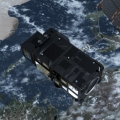|
The table below lists and provides further information
on the
different components of the SecondTest
Data Set.
Data types and
providers:
The algorithms used
to generate this data set are
described in the L1 Algorithm
Theoretical Basis Document (ATBD), the L2
Algorithm
Theoretical Basis Document (ATBD), and
the products are described in the Product
Specification Document (PSD).
Login information for
the SCOOP ftp server is available
on request by email from scoop.info at esa.int.
|
Region
|
C-2 Mask
|
Location
|
Period
|
Input Data
|
SCOOP Second Test Data
Set
|
|
ROI_01
|
CP4O_002
|
West Pacific
|
01/10/2012- 31/12/2013
|
C-2 FBR [8] 2012 2013
|
L1B_S3
|
L2_S3
|
|
|
RDSAR
|
|
WTC
|
|
ROI_02
|
CP4O_003
|
Central Pacific
|
01/10/2012- 31/12/2013
|
C-2 FBR [8] 2012 2013
|
L1B_S3
|
L2_S3
|
|
|
RDSAR
|
|
WTC
|
|
ROI_03
|
SAR_Pico_00
|
East Pacific
|
01/05/2012- 31/12/2013
|
C-2 FBR [8] 2012 2013
|
L1B_S3
|
L2_S3
|
|
|
RDSAR
|
|
WTC
|
|
ROI_04
|
AN6524_1,
AN6524_5,AN6524_6
|
Northeast Atlantic
|
01/01/2012- 31/12/2013
|
C-2 FBR [8] 2012 2013
|
L1B_S3
|
L2_S3
|
Exptl Coastal
|
|
RDSAR
|
|
WTC
|
|
ROI_05
|
AN6524_4
|
North Sea
|
01/01/2012- 31/12/2013
|
C-2 FBR [8] 2012 2013
|
L1B_S3
|
L2_S3
|
Exptl Coastal
|
|
RDSAR
|
RDSAR MLE4
|
WTC
|
|
ROI_06
|
Agulhas
|
Agulhas
|
01/01/2012- 31/12/2013
|
C-2 FBR [8] 2012 2013
|
L1B_S3
|
L2_S3
|
Exptl Coastal
|
|
RDSAR
|
|
WTC
|
|
ROI_07
|
CP4O_001
|
Cuba
|
30/01/2019- 01/04/2019
|
S3a, S3b L1A [9]
|
|
|
|
Cuba Coastal[4]
|
|
|
|
|
ROI_08
|
ESurge_1
|
North Indian Coast
|
01/10/2012- 31/12/2013
|
C-2 FBR [8] 2012 2013
|
L1B_S3
|
L2_S3
|
Exptl Coastal
|
|
RDSAR
|
|
WTC
|
|
ROI_09
|
AN6531_4
|
Indonesia
|
01/01/2012- 31/12/2013
|
C-2 FBR [8] 2012 2013
|
L1B_S3
|
L2_S3
|
Exptl Coastal
|
|
RDSAR
|
|
WTC
|
|
ROI_10
|
Harvest
|
California
|
01/12/2015- present
|
C-2 FBR [8] 2015-6
|
L1B_S3
|
L2_S3
|
Exptl Coastal
|
|
RDSAR
|
|
WTC
|
Notes:
1. L1B
products have been processed by isardSAT. Key aspects are:
- Zero-padding
(factor 2) in range
- Intra-burst
windowing (Hamming)
- Approximate
beamforming (azimuth processing)
- Cut stack edges
(restrict to look angles > -0.6°
or < 0.6°)
- No intra-burst
alignment
2. L2 products have been generated by isardSAT. Key
aspects are:
- In-house
isardSAT implementation of SAR ocean
retracker (Ray et al. 2015)
- Adapted to L1B
processing
modifications(consistency
L1B-L2).
- Fixed PTR
settings (not SWH dependent), based on S3
IPF (azimuth PTR coefficient = 0.3831; range PTR coefficient = 0.513)
- Sigma0 bias applied
3. "Experimental"
Coastal Data Set. A new isardSAT
scheme was implemented that instead takes the first window delay of the
first full ocean return as the reference, thus waveforms are aligned
with respect to the first burst or look in the stack marked as ocean
and not lost. This ocean decision is based on the rough ocean/land mask
from the FBR at burst level. This data set was produced for internal
assessment and validation, but because the analysis did not show an
improvement on the existing SAR Mode Test data set (indeed performance
was worse in some regions), it has not been made publicly available.
The processing is described in Makhoul
(2018) - Report to Acceptance Review.
4. Cuba Coastal Data
Set. The isardSAT processing uses
the MSS2 mean sea surface field in the product (MSS DTU15) to fix the
initial position of the retracking point, and limits the waveform to a
number of range bins around this point. The processing is described in Garcia
(2018) - Report to Acceptance Review.
5. RDSAR
products are processed by
TU Delft from the Cryosat FBR Baseline C data set. The main processing
chain remained the same for the RDSAR Test Data Set 2. The most recent
corrections and models were applied, and the orbits updated to the GDRE
standard (more information is available in the RADS4 manual
(https://github.com/remko/rads).
6. Because of the
uncertainties
in the
attitude information in the CryoSat products (Scagliola et al,
2018), a small data set using an MLE4 retracker was generated for
SCOOP, covering the North Sea Region of Interest. This data set is also
available on request.
7. The Wet
Troposphere
Correction, produced by
the
University of Porto, is the
same as for TDS1. Reference M. Joana Fernandes and Clara Lazaro,
GPD+ Wet Tropospheric Corrections for CryoSat-2 and GFO Altimetry
Missions, Remote Sensing 2016, 8(10), 851; doi:10.3390/rs8100851
(http://www.mdpi.com/2072-4292/8/10/851)
8. The input
data to
the Second SCOOP Test Data Set are
Cryosat-2 Full Bit Rate (FBR) data, Baseline C processing. These input
data were retrieved for the project by ESA / ESRIN and provided to the
project team on hard disk. They are not available through the project
pages but can be accessed directly
from ESA. The input files are
listed by year in links.
9. Sentinel 3a
(cycles 41 and 42) and Sentinel 3b (cycle
22 and 23) L1A closed loop tracking mode data from Feb-March 2019 were
used as
input for generating part of the Cuba Coastal Data set
|

